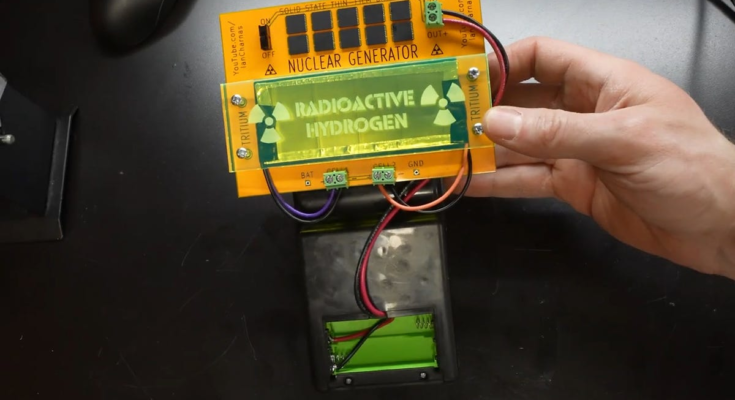Although the Sega Game Gear seemed perpetually starved for fresh batteries, even the Game Boy had a strong appetite for Duracells and Energizers. Modern portables like the Switch simply need an overnight charge, but to ensure he can continue playing Tetris in a post-apocalyptic wasteland, Ian Charnas created a nuclear-powered handheld that needs no batteries whatsoever.
When you think of nuclear power, what comes to mind is probably a giant power plant with those distinctly curved cooling towers generating enough power to light up several cities. But smaller versions exist too, allowing military vehicles like submarines and aircraft carriers to remain deployed for months on end without the need to return to port for a fill-up. That’s not the approach Charnas took, however, because while anyone can purchase uranium ore, refining it for use in large-scale reactors is highly regulated.
Radioactive decay, where an atom loses energy by emitting electrons, is technically known as nuclear power if you find a way to harness the process to generate electricity, and that’s exactly what Charnas has done with this clever hack. Instead of using uranium, however, he takes advantage of a hydrogen isotope known as tritium. If you’re into watches, you’re most likely familiar with tritium as it’s used to illuminate a watch face without the need for LEDs or even batteries. The tritium is sealed inside a glass tube that’s coated on the inside with a phosphor material that glows as electronics emitted from the material hit it, similar to how old CRT TVs worked. These tritium tubes can glow for as long as 25 years, which is how Charnas was able to harness them as a power source.
If something appears to glow, it means it’s emitting light, and if something emits light, a solar cell can harness the illumination to generate usable electricity. Charnas created a sort of nuclear battery by sandwiching a bunch of tritium tubes between two solar cells and then sealing the whole thing up so all of the light emitted by the tubes had no way to escape and was only exposed to the cells. The result was a whopping 1.5 microwatts of electricity—which is not a lot. For the nuclear battery to power something like a hairdryer, Charnas would need to build 1.2 billion of them—that’s a lot.
Because the original Game Boy, arguably the most iconic Tetris-playing device of all time, runs on four AAs, Charnas instead turned to a cheap modern knock-off that requires considerably less power to play the block-stacking game on a segmented LCD display. The nuclear battery still wasn’t strong enough to power the handheld in real-time, but by using it to slowly charge a thin-film solid-state battery (which exhibits very little power leakage) Charnas found that he could play Tetris for an impressive 55 minutes before the batteries needed a recharge.
G/O Media may get a commission
Unfortunately, 55 minutes of playtime required an entire two months of charging, which makes the nuclear battery a less than ideal solution compared to the modern convenience of power outlets. But should the world ever return to the dark ages where electricity is no longer readily available, Charnas will at least have a welcome distraction from the misery every few months.



